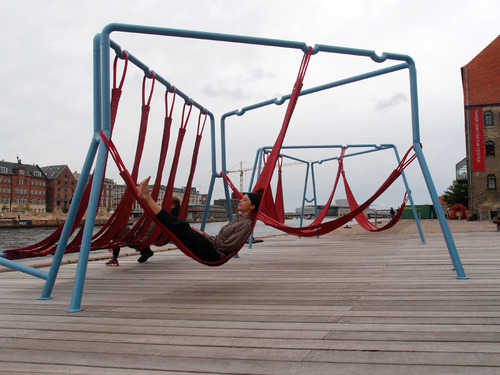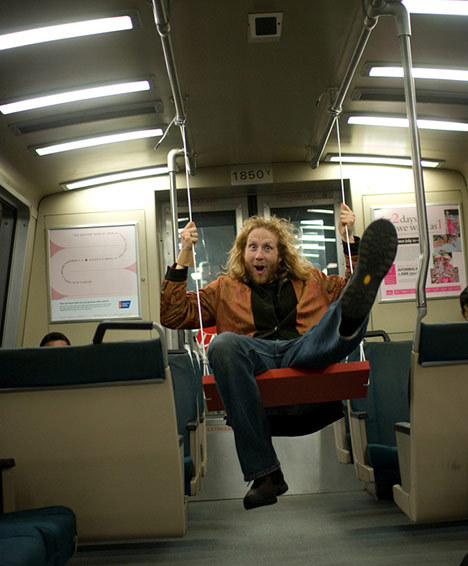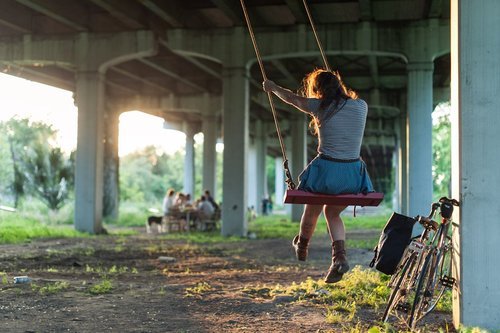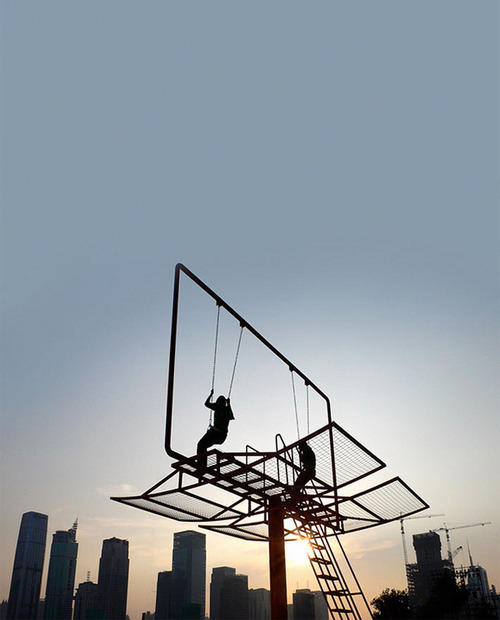Creative Placemaking: Swinging in the City
It is hard to write about swings without sounding cheesy, but there is something about being on a swing that offers the experience of pure joy and freedom. Swings can transform a mundane environment (like a bus shelter, abandoned alley, etc.) into an opportunity to play. This feeling is typically reserved for children, but architects, urbanists and artists around the world are bringing swings to the city in creative, playful installations for everyone to enjoy. I was surprised to see how many examples of urban swings have been popping up around the world. Here is a snapshot:
Photo c/o Playscapes
Off Ground: The "Off-Ground" project by Amsterdam-based designers Jair Straschnow and Gitte Nygaard seeks to embrace play elements so that they can be used as alternative public seating. They ask, "Play is essential to our well being. Why is play most commonly associated with children? What do all seating facilities in public space sum up to rigid benches?" This resulted in their creation of a public space installation of swinging, suspended red hammocks (made of old fire hoses) at the Danish Architecture Center in Copenhagen, Denmark.
Photo: Audrey Penven, CC
Swings on Subways: On a Monday night back in 2009, some pranksters infiltrated the BART, San Francisco's public train system, and installed three read swings in the aisles. Not particularly practical in the long term, but a pretty awesome swing intervention. You can see more examples at the dedicated Flickr site. A similar project by Caroline Woodard involved swings being placed on New York subways in 2006.
Public Furniture Interventions: Dutch designer Thor ter Kulve transforms everyday city fixtures and imbues them with childlike zest - turning a fire hydrant into a fountain, and a boring light pole into a swing. According to Thor, "Thanks to [these designs], dull and derelict places become hangouts of choice…It's my strong belief that in a time of economic hardship and individual isolation, we should address ourselves to public space as a collectively owned domain and possible ways to use it to our joint benefit."
Photo by Oliver Blouin
Swing Set Orchestra: Melissa Mongiat and Mouna Andraos designed the '21 balançoires' for the quartiers des spectacles in Montreal, Canada. "A giant collective instrument made of 21 musical swings; each swing in motion triggers different notes, all the swings together compose a piece, but some sounds only emerge from cooperation. The project stimulates ownership of the new space, bringing together people of all ages and backgrounds, and creating a place for playing and hanging out in the middle of the city centre."
Photo c/o urbaninteraction.net
The Red Swing Project - this project started in February 2007 as an urban intervention within the city of Austin, Texas. The swings are made of red painted wood and hung using retired rock climbing rope. Over the years, the project has seen over 200 red swings hung in USA, India, Thailand, Brasil, Taiwan, South Korea, France, Spain, Portugal, Haiti, Poland, Italy, Germany and Australia. Andrew Danziger, the University of Texas architecture student who started the project, states the goal is to "inspire playfulness around the world."
Photo by Didier Faustino, via dvice.
Double Happiness - Architect Didier Faustino created this swing set out of a converted advertising billboard for the Shenzhen-Hong Kong Bi-City Biennial of Urbanism and Architecture. According to Faustino: "Double Happiness responds to the society of materialism where individual desires seem to be prevailing over all. This nomad piece of urban furniture allows the reactivation of different public spaces and enables inhabitants to re-appropriate fragments of their city. They will both escape and dominate public space through a game of equilibrium and disequilibrium. By playing this "risky" game, and testing their own limits, two persons can experience together a new perception of space and recover an awareness of the physical world."
Photo by Ann De Haas
Secret Swing - This covert swing was an art installation that consisted of a playground swing hanging in the narrow space between two buildings in Toronto, Canada. The swing was accessed by way of the alley behind Queen Street West. Toronto artist Corwyn Lund erected the swing in September 2003 as part of a group show called 'Psychotopes' at YYZ Artists Outlet. The swing installation came to an end in March 2006 when both the swing and the bar holding it up were removed and a fence installed to block the entrance to the space where the swing was installed.
Urban Recreation: One of the original swing projects, Akay and Peter, also known as the Barsky Brothers, were once graffiti artists in Stockholm who decided to turn the streets into their playground with an intervention that was 'an act of re-creation through recreation'. Their projects included the installation of a holiday cottage and communal picnic table on a traffic island, a silhouette 'zoo' in a vacant highway lot, and a tiny wooden trailer for kids used to set up camp. And for several months in 2004, they installed sixty-five swings made of found material - a milk crate, a bench plank from McDonalds - around Stockholm. According to the artists:
"There is something simply charming and disarming about swings. It's hard to describe the feeling of watching crowds of people hurrying along the sidewalks, then suddenly seeing someone break away, take a seat, and start swinging. It's like love. There's a feeling of instant affection for any individual who would stop everything and just take advantage of the moment, allowing herself to get swept away."
Photo c/o Jeff Walderman
Swings: Bolivia - Jeff Waldeman has been installing urban swings around the world for in cities like LA, San Francisco and Panama as a random act of kindness. According to Jeff, swings tug at our most basic emotions and produce simple, unadulterated joy:
"We've received notes from those that used the swings, talking about the surprising smiles that were left on their faces. They wrote how their days were made better and how the emotions that emerged from stumbling across and using a random swing permeated their afternoon and infected those they came into contact with. The joy felt and the urge to spread it was contagious."
He received $11,200 through Kickstarter in 2011 to install swings in Bolivia, a country with the second highest poverty level in South America.









